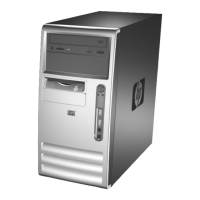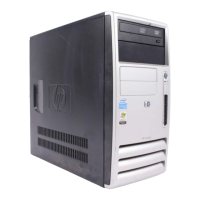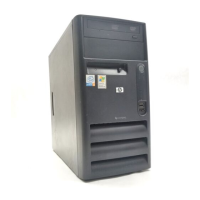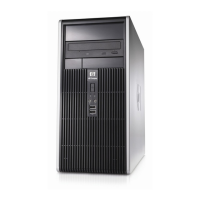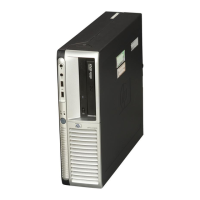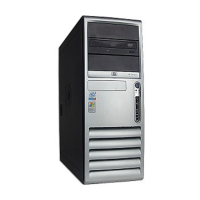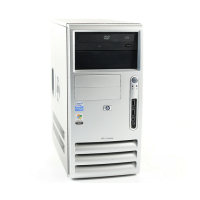
Do you have a question about the HP Compaq dx2450 MT and is the answer not in the manual?
| Form Factor | Microtower |
|---|---|
| Power Supply | 300W |
| Processor | AMD Athlon 64 X2 Dual-Core |
| Storage | Up to 500 GB |
| Graphics | Integrated |
| Optical Drive | DVD-ROM |
| Audio | Integrated audio |
| Network | 10/100/1000 Ethernet |
| Ports | USB 2.0, VGA, serial, parallel |
| Operating System | Windows Vista Business |
| Expansion Slots | PCI, PCIe x1, PCIe x16 |
| Weight | Approx. 20 lbs |
Guides on the automatic installation process for the operating system, including initial setup.
Instructions for installing or updating device drivers after the operating system is installed.
Information on using HP's software for backing up and recovering the computer's data.
Overview of the Computer Setup utility and its capabilities for configuring system settings.
Step-by-step instructions on how to access and navigate the Computer Setup utility.
Details on the 'Main' menu options within the Computer Setup utility.
Details on the 'Advanced' menu options within the Computer Setup utility.
Details on the 'Power' menu options within the Computer Setup utility.
Details on the 'Boot' menu options within the Computer Setup utility.
Details on the 'Exit' menu options within the Computer Setup utility.
Procedure to reset BIOS Setup options to their default values.
Overview of the utility for viewing hardware configuration and performing diagnostic tests.
Steps to access HP Insight Diagnostics, including creating a recovery disc set.
Details on selecting test types and modes within HP Insight Diagnostics.
Information on monitoring test progress and results in HP Insight Diagnostics.
Explanation of the Log tab for viewing test execution and error details.
Information on accessing help topics, error codes, and test components.
Instructions for saving and printing diagnostic information to removable media.
Guide to obtaining the most current version of HP Insight Diagnostics from the HP website.
Recommendations for backing up system software and applications to prevent data loss.
Characteristics and identification of SATA Hard Drives.
Details on SATA data and power cables, including pin assignments and handling.
Pin assignments and usage for SATA power connectors.
Information regarding Parallel ATA (PATA) devices, specifically optical drives.
Explanation of Self Monitoring Analysis and Recording Technology (SMART) for hard drives.
Information on drive and partition capacity limits based on file system and OS.
Identifies the computer's chassis type, specifically the Microtower (MT).
Information on the risks of ESD and how it can damage electronic components.
Precautions and methods for preventing damage from electrostatic discharge.
Details on grounding methods and equipment to prevent static electricity damage.
Precautions for preparing and maintaining a static-free work area.
Guidelines for operating the computer to prevent overheating and prolong its life.
Procedures for routine maintenance, including cleaning the computer's exterior and components.
Information on locating the unique serial and product ID numbers for the computer.
Essential steps and safety precautions before disassembling the computer.
Description of devices used to prevent unauthorized access or secure the computer.
Procedure for removing and installing the computer's side access panel.
Procedure for removing and reinstalling the computer's front bezel.
General guidelines and procedures for installing and removing various types of drives.
Information about the computer's memory modules (DIMMs) and installation.
Procedures for removing, replacing, or adding expansion cards to the system board.
Instructions for removing and installing the computer's processor.
Procedure for removing and replacing the computer's power supply unit.
Instructions for removing and installing the computer's system board.
Information on the computer's lithium coin cell battery and replacement procedures.
Procedure for replacing the battery in a Type 1 battery holder.
Procedure for replacing the battery in a Type 2 battery holder.
Procedure for replacing the battery in a Type 3 battery holder.
Pin assignments for the keyboard connector.
Pin assignments for the mouse connector.
Pin assignments for the Ethernet BNC connector.
Pin assignments for the Ethernet RJ-45 connector.
Pin assignments for the parallel interface connector.
Pin assignments for the USB connector.
Pin assignments for SATA data and power connectors.
Pin assignments for PCI Express connectors.
Applicable requirements for power cord sets in all countries.
Additional requirements specific to various countries for power cord sets.
Safety precautions and guidelines for a comfortable and safe work environment.
Steps to take to isolate problems before contacting technical support.
General suggestions and checks for common computer, monitor, or software problems.
Solutions for common computer problems like no power or system lock-ups.
Troubleshooting steps for issues arising from adding or removing hardware.
Guide to understanding and diagnosing problems based on POST beep codes.
Physical dimensions of the computer chassis.
Operating and non-operating temperature ranges for the computer.
Operating and non-operating relative humidity limits for the computer.
Maximum operating and non-operating altitudes for the computer.
Information on the maximum and typical heat dissipation of the computer.
Specifications for the computer's power supply, including voltage and output.



